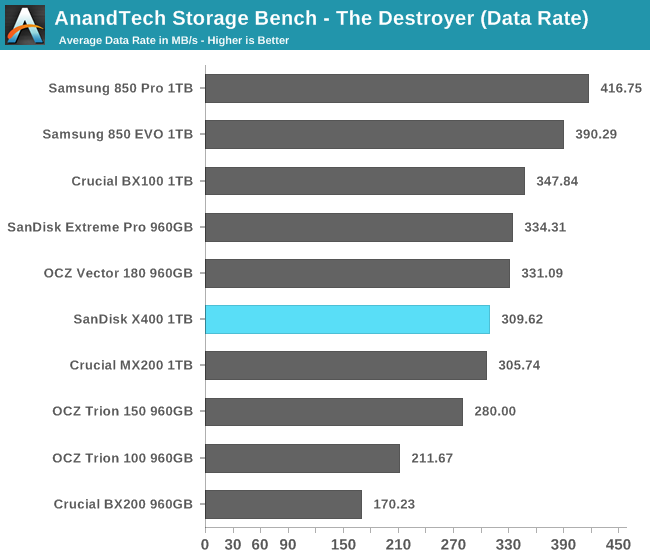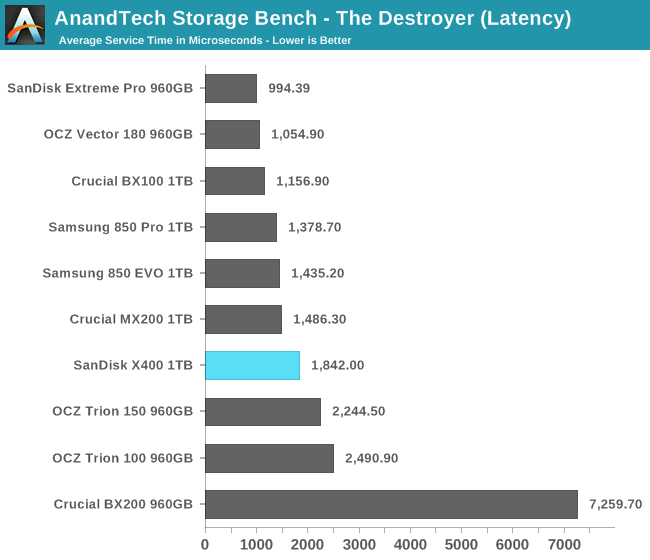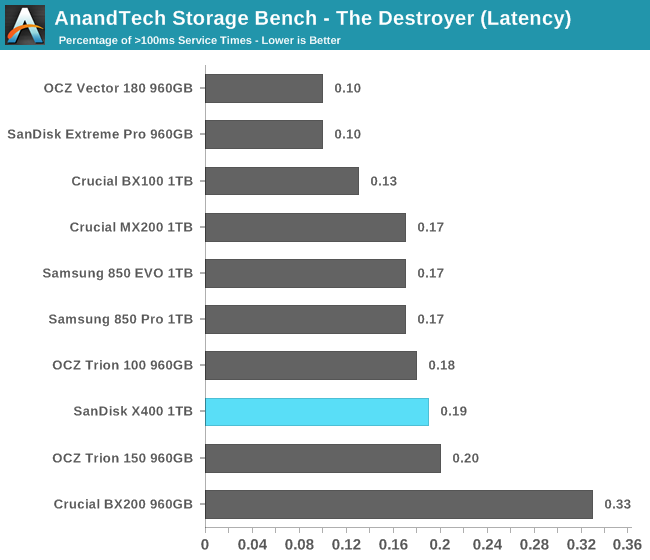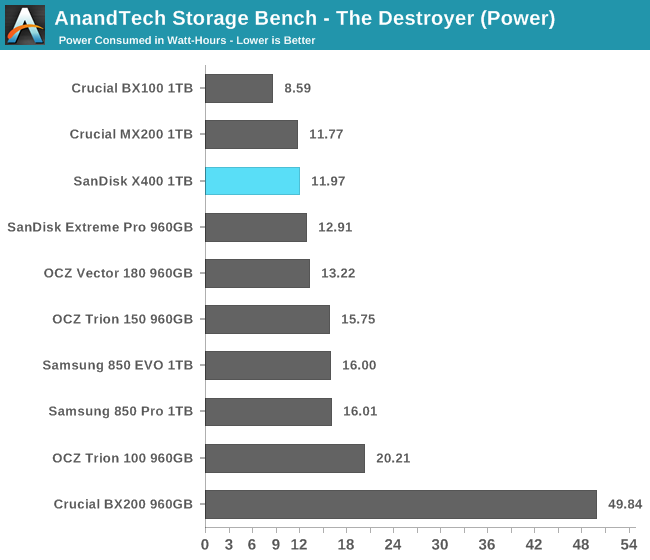The SanDisk X400 1TB SSD Review
by Billy Tallis on May 6, 2016 9:00 AM ESTAnandTech Storage Bench - The Destroyer
The Destroyer is an extremely long test replicating the access patterns of very IO-intensive desktop usage. A detailed breakdown can be found in this article. Like real-world usage and unlike our Iometer tests, the drives do get the occasional break that allows for some background garbage collection and flushing caches, but those idle times are limited to 25ms so that it doesn't take all week to run the test.
We quantify performance on this test by reporting the drive's average data throughput, a few data points about its latency, and the total energy used by the drive over the course of the test.

The X400's average data rate on The Destroyer places it clearly ahead of the other planar TLC drives and on par with the Crucial MX200.

The average service time for the X400 doesn't quite compete against the MLC drives, but it does put the X400 clearly ahead of the budget TLC drives.

The X400's latency outliers at the 10ms threshold again put it ahead of the budget drives but also clearly behind the MLC drives and the Samsung 850 EVO.

At the 100ms threshold for latency outliers most drives in this roundup score very close to each other, and the X400 is a little slower than average.

The X400's power usage over the course of The Destroyer is pretty good, especially for a TLC drive. Most of the faster drives sacrifice some efficiency.










41 Comments
View All Comments
Margalus - Friday, May 6, 2016 - link
It uses less power than some, and is priced lower. But it seems performance is severely lacking..jabber - Friday, May 6, 2016 - link
This just shows what a fantastic budget SSD the BX100 was. Crucial were stupid to dump it.Mixal11 - Sunday, May 8, 2016 - link
Exactly, for me it's v300 for low end desktop, BX100 for laptops (hard to get over time) and Sandisk Extreme Pro or 850 Pro for high end. I avoid TLC, because of experience with Dell Samsung 841oem. Who knows if I can read data from it after year or two. TLC drives are great to reduce ssd prices.jabber - Sunday, May 8, 2016 - link
Yeah everyone moaned about the V300's back in the day but they are perfect SSDs for putting in SATA II kit as they push 285+MBps all day long...plus they are the cheapest you can buy usually. Also I have bought dozens of them and not one has yet failed. They are a solid tough little SSD. I shall be sorry when they go.jhh - Friday, May 6, 2016 - link
I wonder if they have included any of the increased endurance technology from their Smart Storage (formerly part of Smart Modular) acquisition. The idea behind the technology was that most cells didn't need full current to program, and when programmed with less than full current, that the cell would allow more write/erase cycles.Michael Bay - Friday, May 6, 2016 - link
Goddamn it, one more terabyte.Just one.
Samus - Friday, May 6, 2016 - link
I think if I were shopping for a TLC drive I'd stick with Sandisk too. I haven't had any issues with their Ultra II's, although many people have. I have, however, had two ADATA SP550's fail (a 120GB and 240GB) one during a power failure in a laptop (BSOD) which a secure erase recovered usability of the drive, and another within an hour of installation - cloning about 100GB of data to it killed it an no longer detects by BIOS.I have 5 or so other SP550's in the field running fine though, but none of them have suffered the "abuse" of the above cases.
I have dozens of Mushkin drives out there, even ECO2's, all running incredibly well. I have a few ECO3 TLC drives in house about to go out, but I've been avoiding them because the ECO2 is still available.
On a side note, I still have 840EVO's coming in at least bi-weekly with basically unusable performance. Samsung is hell to deal with for RMA (a stark contrast to, say, OCZ that actually sends you an advanced replacement!) and nothing I can do revives performance in these drives. Secure erase, fill and trim, etc, nothing works. Even after a fresh OS install they read at half the speed they write. It's crazy, slower than a 2.5" hard disk.
ladder_to_heaven - Friday, May 6, 2016 - link
Win 8.1 - STILL? -For the love of god WHY?
Billy Tallis - Friday, May 6, 2016 - link
Switching to Windows 10 would require re-testing a lot of drives, monopolizing the testbed for a month. It'll probably happen at some point this year, but I'll need to put together a second system for it (hopefully a Skylake system with working PCIe power management).jabber - Saturday, May 7, 2016 - link
Yeah no rush, after all 85% of 10's code is...8.1.